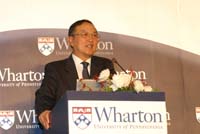Looking for more insights?
Sign up to stay informed about our latest article releases.
Lenovo Group, China’s largest personal computer manufacturer, gained a great deal of attention when it acquired IBM’s PC unit in 2004. The company has encountered some serious challenges since then, but co-founder Liu Chuanzhi -- who returned to his position as chairman at the beginning of this year, after stepping down following the IBM deal -- is confident that Lenovo can turn the situation around. In a keynote speech delivered at the Wharton Global Alumni Forum in Beijing in June, he highlighted several principles for building a healthy company. Liu also discussed the landmark year of 1994, when the groundwork was laid for Lenovo’s later success.

Sign up to stay informed about our latest article releases.